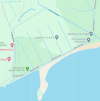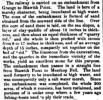This is a
more recent (and not paywalled) article, from The (NWE) Mail, in part saying:
(I do like that quote about "the biggest problem is there is too much sand and silt in Morecambe Bay" - very Lewis Carroll!)
J T Atkinson's yard is next to the footbridge at Blawith Point, so that's where this Seldom Seen Culvert is. The text says there is a second outlet, but not where it is. This bit:
sounds to me as if this flap valve has to be at the other end, where the Winster is. A channel leading there is shown on the excerpt from Google Maps (above), though the old OS maps are much less clear on this.
There is also a significant water channel in the sands to the east of the Holme Island causeway, so that's another possible site for a culvert. Note that there is no visible channel through the sands at Blawith Point, suggesting this outfall really is blocked.
The repair work is mentioned too:
Network rail isn't mentioned as having any responsibility, even for the core of the embankment itself, except in a quote form Tim Farron MP suggesting they should work together with the relevant bits of government. I wonder if some quirk of legal history really has let them off that hook"



